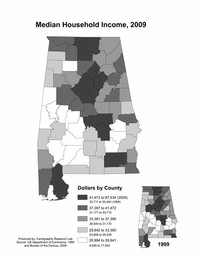Facts about Alabama

Alabama generally ranges in elevation from sea level at Mobile Bay to over 1,800 feet (550 m) in the Appalachian Mountains in the northeast.

The North Alabama region is mostly mountainous, with the Tennessee River cutting a large valley creating numerous creeks, streams, rivers, mountains, and lakes.

The city was incorporated in 1819, as a merger of two towns situated along the Alabama River.

From 1876 through 1956, Alabama supported only Democratic presidential candidates, by large margins.

Among the Native American people once living in the area of present-day Alabama were Alabama (Alibamu), Cherokee, Chickasaw, Choctaw, Creek, Koasati, and Mobile.

Cherokee and other Native Americans who occupied land in Alabama were forcibly removed in 1838 and forced to trek more than 1,000 miles to Indian Territory in present-day Oklahoma.

Public school funding is appropriated through the Alabama Legislature through the Education Trust Fund.

In 1972, for the first time since 1901, the Alabama constitution's provision for periodic redistricting based on population was implemented.

The word Alabama is believed to have originated from the Choctaw language and was later adopted by the Alabama tribe as their name.

The climate of Alabama is described as temperate with an average annual temperature of 64°F (18 °C).

In 1861 Alabama seceded from the Union to join the Confederate States of America.

African Americans were not the only residents of Alabama to suffer at the hands of racism.

UAB is now the area's largest employer and the largest in Alabama, with a workforce of about 20,000.

Following Reconstruction, Alabama was readmitted to the Union in 1868.

The states bordering Alabama include Tennessee to the north; Georgia to the east; Florida to the south; and Mississippi to the west.

Alabama is an alcoholic beverage control state; the government holds a monopoly on the sale of alcohol.

Alabama's GDP increased 3.1 percent from 2005, placing Alabama number 23 in terms of state-level GDP growth.

Alabama is divided into three equal branches: The legislative branch consists of the House of Representatives, with 105 members, and the Senate, with 35 members.

Volunteer militias from Georgia, South Carolina, and Tennessee marched into Alabama, fighting the Red Sticks.

Due to the restraints placed in the Alabama Constitution, all but seven counties (Jefferson, Lee, Mobile, Madison, Montgomery, Shelby, and Tuscaloosa) in the state have little to no home rule.

Conflict between the Indians of Alabama and American settlers increased rapidly in the early nineteenth century.

Alabama currently ranks second in the nation behind Detroit in automobile output.

Alabama has coastline at the Gulf of Mexico, in the extreme southern edge of the state.

Alabama is also home to the largest industrial growth corridor in the nation, including the surrounding states of Tennessee, Mississippi, Florida, and Georgia.

Alabama was the twenty-second state admitted to the Union, in 1819.

The rate of population growth rate in Alabama dropped by nearly half in the decade from 1910 to 1920, reflecting the outmigration.

Like other states in the South, Alabama is burdened by the legacy of slavery and racial segregation, a pattern that lasted until the civil rights movement and federal legislation forced changes.

Someday Alabama may surpass Michigan and become the largest automobile manufacturer in North America.

Alabama ranks 30th in total land area and ranks second in the size of its inland waterways.

From the American Civil War until World War II, Alabama, like many southern states, suffered economic hardship, in part because of continued dependence on agriculture.
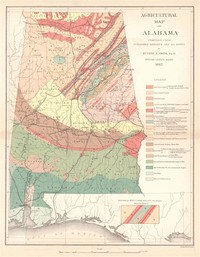
Alabama's agricultural outputs include poultry and eggs, cattle, plant nursery items, peanuts, cotton, grains such as corn and sorghum, vegetables, milk, soybeans, and peaches.

Alabama's rate of violent crimes peaked in the early 1990s before beginning to decline, however the state's prisons are overpopulated.

Any policy changes proposed around the state must be approved by the entire Alabama legislature and, frequently, by state referendum.

Alabama's programs of higher education include 14 four-year public universities, numerous two-year community colleges, and 17 private, undergraduate, and graduate universities.
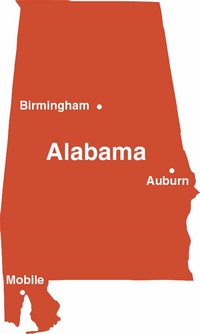
Alabama receives an average of 56 inches (1,400 mm) of rainfall annually and enjoys a lengthy growing season of up to 300 days in the southern part of the state.

Public primary and secondary education in Alabama is under the overview of the Alabama State Board of Education as well as local oversight by 67 county school boards and 60 city boards of education.

The Democrats won with John F. Kennedy on the ballot, but the Democratic electors from Alabama gave 6 of their 11 electoral votes as a protest to Harry Byrd.

Northern and central Alabama was part of Georgia from 1763 to 1783 and part of the American Mississippi territory thereafter.

The foundational document for Alabama's government is the Alabama Constitution, which was ratified in 1901.

South Alabama reports more thunderstorms than any part of the United States.

In 2004, George W. Bush won Alabama's nine electoral votes by a margin of 25 percentage points with 62.5 percent of the vote, mostly white voters.
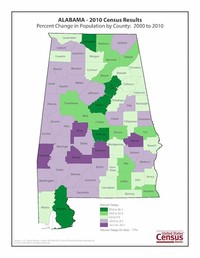
According to U.S. census data, Alabama's high school graduation rate—75 percent—is the second lowest in the United States (after Mississippi).

Alabama state politics gained nationwide and international attention in the 1950s and 1960s during the American Civil Rights Movement, when majority whites bureaucratically, and at times violently, resisted protests for electoral and social reform.

Alabama shares the dubious distinction, with Kansas, of having reported more F5 tornadoes (the most powerful) than any other state for the period January 1, 1950 to October 31, 2006.

Most of this growth is due to Alabama's rapidly expanding automotive manufacturing industry.

The North Alabama region is mostly mountainous, with the Tennessee River cutting a large valley creating numerous creeks, streams, rivers, mountains, and lakes.

Montgomery is the capital, second most populous city, and the 4th most populous metropolitan area in Alabama, and is the county seat of Montgomery County.

In 2007, the Alabama state legislature passed a resolution expressing "profound regret" over slavery and its lingering impact.

Alabama's industrial outputs include iron and steel products (including cast-iron and steel pipe); paper, lumber, and wood products; mining (mostly coal); plastic products; cars and trucks; and apparel.

The agrarian Mississippian culture covered most of the state from 1000 to 1600 C.E., with one of its major centers being at the Moundville Archaeological Site in Moundville, Alabama.

Southern Alabama was French from 1702 to 1763, part of British West Florida from 1763 to 1780, and part of Spanish West Florida from 1780 to 1814.

By the terms of the treaty the Creeks, Red Sticks and neutrals alike, ceded about one-half of the present state of Alabama.

Under the Voting Rights Act, cases were filed in federal courts to force Alabama to properly redistrict by population both the state House and Senate.

In 2007, the Alabama legislature passed, and the governor signed, a resolution expressing "profound regret" over slavery and its lingering impact.

The largest reported ancestry groups in Alabama are: African American (26.0 percent), American (17.0 percent), English (7.8 percent), Irish (7.7 percent), German (5.7 percent), and Scots-Irish (2.0 percent).

Alabama is a state located in the southern region of the United States of America.

The city of Mobile, Alabama's only saltwater port, is a busy seaport on the Gulf of Mexico with inland waterway access to the Midwest via the Tennessee-Tombigbee Waterway.

Later cessions by the Cherokee, Chickasaw, and Choctaw in 1816 left only about a quarter of Alabama to the tribes.
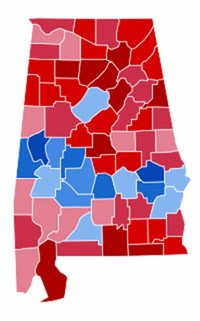
By contrast, Democratic candidates have been elected to many state-level offices and comprise a long-standing majority in the Alabama legislature.
The only state with the major natural resources to make iron and steel, Alabama is the largest supplier of cast-iron and steel pipe products. Huntsville, Alabama is known as the Rocket Capital of the World and is home of the George C. Marshall Space Flight Center.
Alabama introduced the Mardi Gras to the western world. ... Alabama workers built the first rocket to put humans on the moon.The world's first Electric Trolley System was introduced in Montgomery in 1886.Alabama is the only state with all major natural resources needed to make iron and steel.More items...
Alabama has been known as the “Yellowhammer State” since the Civil War. The yellowhammer nickname was applied to the Confederate soldiers from Alabama when a company of young cavalry soldiers from Huntsville, under the command of Rev. D.C. Kelly, arrived at Hopkinsville, KY, where Gen. Forrest's troops were stationed.
Alabama, which joined the union as the 22nd state in 1819, is located in the southern United States and nicknamed the “Heart of Dixie.” The region that became Alabama was occupied by American Indians as early as some 10,000 years ago. Europeans reached the area in the 16th century.
Although a member of Pánfilo de Narváez's expedition of 1528 may have entered southern Alabama, the first fully documented visit was by explorer Hernando de Soto. In 1539 he made an arduous expedition along the Coosa, Alabama and Tombigbee rivers.
Let's take a look at just a few of these famous people born in Alabama who have accomplished their dreams and have made Alabama proud.1.) Helen Keller. wikipedia. ... 2.) Mia Hamm. wikimedia commons. ... 3.) Rosa Parks. wikimedia commons. ... 4.) Percy Sledge. ... 5.) Channing Tatum. ... 6.) Jesse Owens. ... 7.) Courteney Cox. ... 8.) Evander Holyfield.More items...
Alabama has no official state nickname, but "The Heart of Dixie" is prevelant and reflects the central role that Alabama played in the history of the South. A major Cotton State, Alabama also became a leading proponent of secession in the days leading up to the Civil War.Jul 28, 2017
Alabama is a state in the southeastern region of the United States. It is bordered by Tennessee to the north, Georgia to the east, Florida and the Gulf of Mexico to the south, and Mississippi to the west. Alabama is the 30th largest by area and the 24th-most populous of the U.S. states.
The origin of the name "Alabama" remains somewhat questionable. Sources vary; the traditional story is that "Alabama" comes from the native American Creek language (meaning "tribal town"). Other sources claim it is derived from the Choctaw language, translating as "thicket-clearers" or "vegetation-gatherers."





